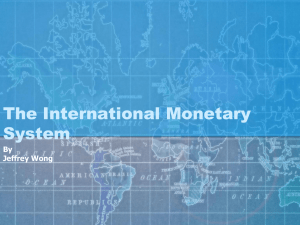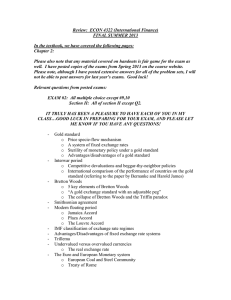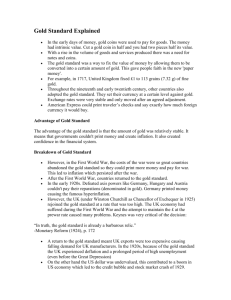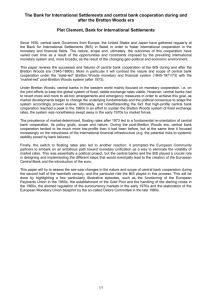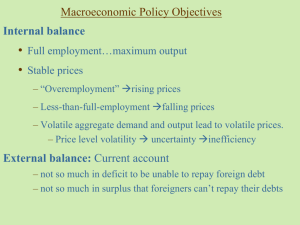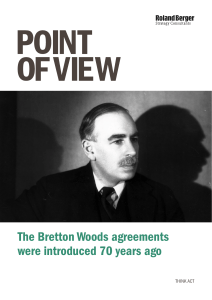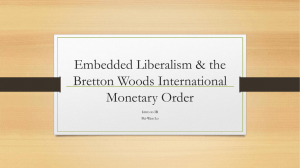International Monetary Systems
advertisement
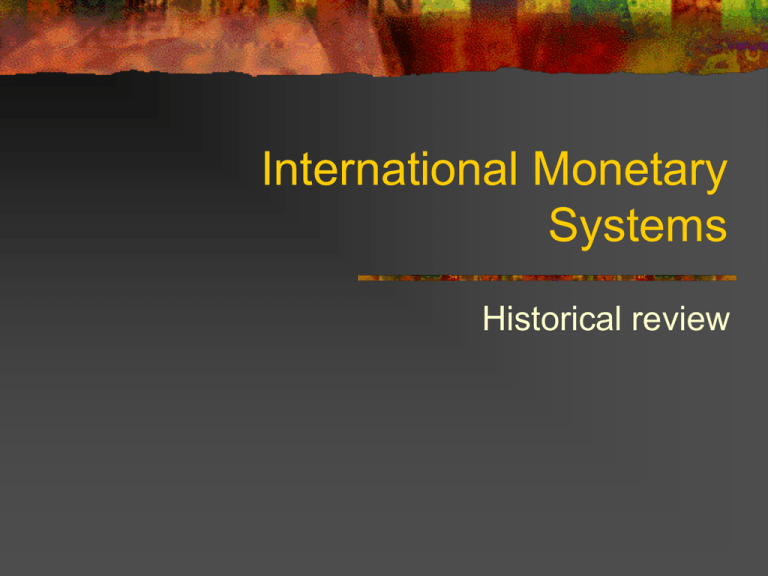
International Monetary Systems Historical review Historical Review Gold Standard: 1870 – 1914 Interwar years: 1918 – 1939 Bretton Woods System: 1944 – 1973 Floating Exchange Rate: 1973 - Gold Standard A commodity money standard = the value of money is fixed relative to a commodity. A gold standard is an example. For example, suppose 1 unit of currency A = 0.10 ounce of gold 1 unit of currency B = 0.20 ounce of gold Then EA/B = 0.20 0.10 = 2 = price of currency B in terms of currency A Gold Standard (cont’d) The gold standard leads all countries to the balance of payment equilibrium (i.e. BOP = 0). BOP < 0 outflow of gold the central bank reacts by reducing its domestic credit holding MS P EP*/P CA BOP>0 inflow of gold MS P EP*/P CA BOP = 0 i capital inflow BOP = 0 Gold Standard (cont’d) So, the system hit by shock will restore the equilibrium. Long-run price stability because money supply is restricted by gold supply. Interwar years: 1918 - 39 During WWI, the gold standard was abandoned by many countries. 1919: US returned to the gold standard little inflation during the war 1925: Britain returned to the gold standard at the parity prevailing before the war Britain’s case MS during and after the war P So, Britain had to have contractionary monetary policies unemployment economic stagnation in 1920s London’s decline as int’l financial center Pound holders lost confidence in pounds and began converting their pound to gold a run on British gold reserves 1931 Britain was forced to abandon the gold standard US’s case 1931: A run on US gold 15% drop in US gold holdings 1933: US left the gold standard. 1934: US returned to the gold standard at $35 per ounce (devaluation from $20.67). 1930s Great depression Int’l economic disintegration A period of competitive devaluations: In trying to stimulate domestic economies by increasing exports, country after country devalued. FX controls Trade barriers int’l monetary warfare Bretton Woods System: 1944 1973 A desire to reform the int’l monetary system to one based on mutual cooperation and freely convertible currencies. 1944: Bretton Woods Agreement Bretton Woods Agreement 1. International Monetary Fund (IMF) Purpose: To lend FX to any member whose supply of FX had become scarce. (To help the countries facing difficulty: CA deficit tight monetary policy employment). Lending would be conditional on the member’s pursuit of economic policies that IMF would think appropriate (IMF Conditionality). Bretton Woods Agreement 2. The US dollar would be designed as a reserve currency, and other nations would maintain their FX reserves in the form of dollars. 3. Each country fixed its ex rate against the dollar and the value of dollar is defined by the official gold price $35 per ounce (Gold Exchange Standard). Bretton Woods Agreement 4. A Fund member could change its par value only with Fund approval and only if the country’s BOP was in “fundamental disequilibrium”. 5. Countries would have to make a payment (subscription) of gold and currency to the IMF in order to become a member. Bretton Woods System Fixed ex rate system imposes restriction on monetary policy of countries. Floating ex rates were regarded as a cause of speculative instability. Decline and Fall of the Bretton Woods System 1958-65: Private capital outflows from US 1965-68: Johnson Administration The bad US macroeconomic policy package caused considerable damage to the US economy and the int’l monetary system. Involvement in the Vietnam conflict “Great Society” program G Deficit MS P & CA (stagflation) Decline of and Fall of BW system 1971: US CA deficit massive private purchase of DM Bundesbank intervened in FX market by buying huge amount of dollars, then it gave up and allowed the DM to float. August 1, 1971: Nixon’s announcement Stop to sell gold for dollars to foreign central banks 10% tax on all imports until revaluation of each country’s currency against the dollars Freeze on prices and wages. Smithsonian agreement December 1971: Smithsonian agreement The dollar was devalued against foreign currencies by about 8% ($38 per ounce of gold). The currencies of the surplus countries were revalued. Maintain the ex rate within ±2.25% of the stated parity. Floating Exchange Rates: 1973 Speculative attacks on the pound and the lira 1972: Britain allowed the pound to float. 1972-73: speculators began selling dollars massively. 1973: US devalued the dollar again ($42.22 per ounce of gold). By March 1973 major currencies were all floating. Managed float: central banks frequently intervene. Choice of Exchange Rate Regimes Fixed or pegged ex rates would work like a gold standard. To keep their prices fixed, countries have to buy or sell their currencies in FX market (FX market Intervention). Floating (Flexible) ex rates --- the ex rates are determined by the market forces of demand and supply. No intervention takes place. A variety of ex rate system Managed Floating: MA influences ex rates through active FX market intervention (Independently) Floating: the ex rate is market determined. No FX intervention. Currency Board: A legislative commitment to exchange domestic currency for a specified foreign currency at a fixed ex rate. A variety of ex rate system Fixed Peg: The ex rate is fixed against a major currency. Active intervention needed. Crawling Peg: The ex rate is adjusted periodically in small amounts at a fixed, preannounced rate. Dollarization: The dollar circulates as the legal tender. Advantage of Flexible rates Each country can produce independent macroeconomic policies. Countries can choose different inflation rates. Advantage of Fixed rates Stable ex rates Each country’s inflation rate is “anchored” to the inflation rate in the US. price stability Disadvantage of Flexible rates The system is subject to destabilizing speculation Increase the variability of ex rates Self-fulfilling prophecy “evening out” swings in ex rates Disadvantage of Fixed rates A country cannot follow macroeconomic policies independent of those of other countries. To maintain the fixed rates, countries need to share a common inflation experience. Choice of Peg or Float Peg Small size (GDP) Open economy Harmonious inflation rate Concentrated trade Float Large size Closed economy Divergent inflation rate Diversified trade
